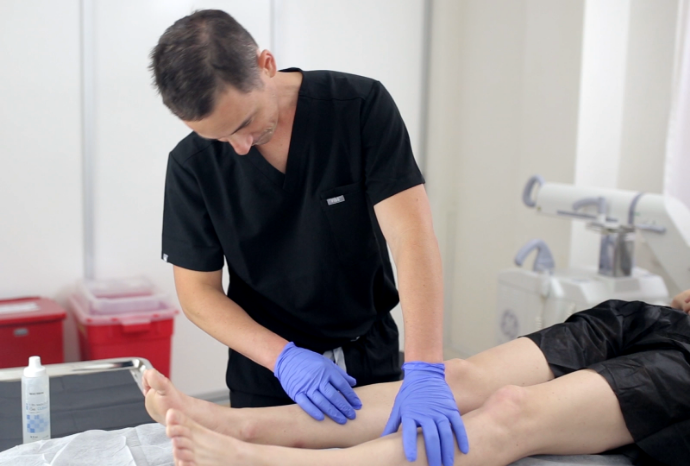The CEAP classification’s C, or clinical score, goes from C0, which indicates that there is no venous disease at all that can be felt or seen in the legs, to C6, which suggests an open and active venous leg ulcer.
CEAP Classification:
The CEAP classification divides varicose veins into several categories:
C0: No visible or palpable signs of venous disease
C1: Telangiectasias or reticular veins
C2: Varicose veins with a diameter larger than 3 mm
C3: Oedema (swelling)
C4: Changes in skin and subcutaneous tissue, including pigmentation, eczema, lipodermatosclerosis, or atrophie blanche
C5: Healed venous ulcer
C6: Active venous ulcer
This classification aids healthcare professionals in understanding the severity of the condition and planning suitable treatment.

Duplex Doppler Ultrasound
For a more in-depth assessment, a Duplex Doppler ultrasound may be performed. This diagnostic tool offers valuable information about the extent of the disease and the presence of reflux (backward blood flow) in the veins and aids in planning treatment options. It is a non-invasive and effective way to visualize the veins and assess their function.
What are the Different Treatment Options of Varicose Veins?
Many people search query what are the treatment options for varicose veins. This is a common question asked by various people.
You can heal from varicose veins with home care treatment options, minimally invasive procedures, and surgeries. Some treatment options are mentioned below:-
Weight Loss and Physical Activity
Encouraging weight loss in overweight individuals and promoting moderate physical activity can help reduce the risk of complications related to varicose veins.
Compression Therapy
Compression stockings or hosiery are frequently recommended to alleviate discomfort and swelling, especially when standing for extended periods or during travel. These garments assist in improving venous blood flow and reducing symptoms.
Endovenous Thermal Ablation
Endovenous thermal ablation is a minimally invasive procedure that employs laser or radiofrequency energy to create irreversible thermal injury in the vein wall. This leads to scarring and eventual absorption of the damaged tissue. The success rate for this method is high, with a success rate of approximately 95%.
Injection Sclerotherapy
Sclerotherapy entails injecting a sclerosant solution directly into the affected veins under ultrasound guidance. This induces inflammation in the veins, leading to their eventual collapse. For smaller surface veins, micro sclerotherapy, which employs smaller gauge needles and smaller amounts of sclerosant, is often used.
Endovenous Adhesive Ablation
Endovenous adhesive ablation, also known as the ‘vein glue’ technique, involves the injection of medical-grade adhesive through a catheter into the vein. Nevertheless, long-term safety and efficacy data for this procedure still need to be improved, and it may not be the first choice for all patients.

Surgery
Surgical procedures such as high-ligation, vein stripping, and avulsion are less commonly used today compared to the past. This is due to post-operative morbidity, recurrence rates, and associated risks such as anesthesia and hospitalization.
Lasers
Long-wavelength vascular lasers are suitable for treating smaller venous issues like telangiectasia and venulectasia. However, they are generally not effective for larger varicose veins.
Cost Indulge in Treating Varicose Veins
How much does varicose vein treatment cost may vary depending on factors such as severity, the affected area, treatment type, and qualified experts you’ve chosen.
Conclusion
Varicose vein is not just an aesthetic concern, but it can cause various complications that influence daily routine activities and mobility. Early diagnosis and appropriate management can help reduce the discomfort and health risks associated with this venous disease.

